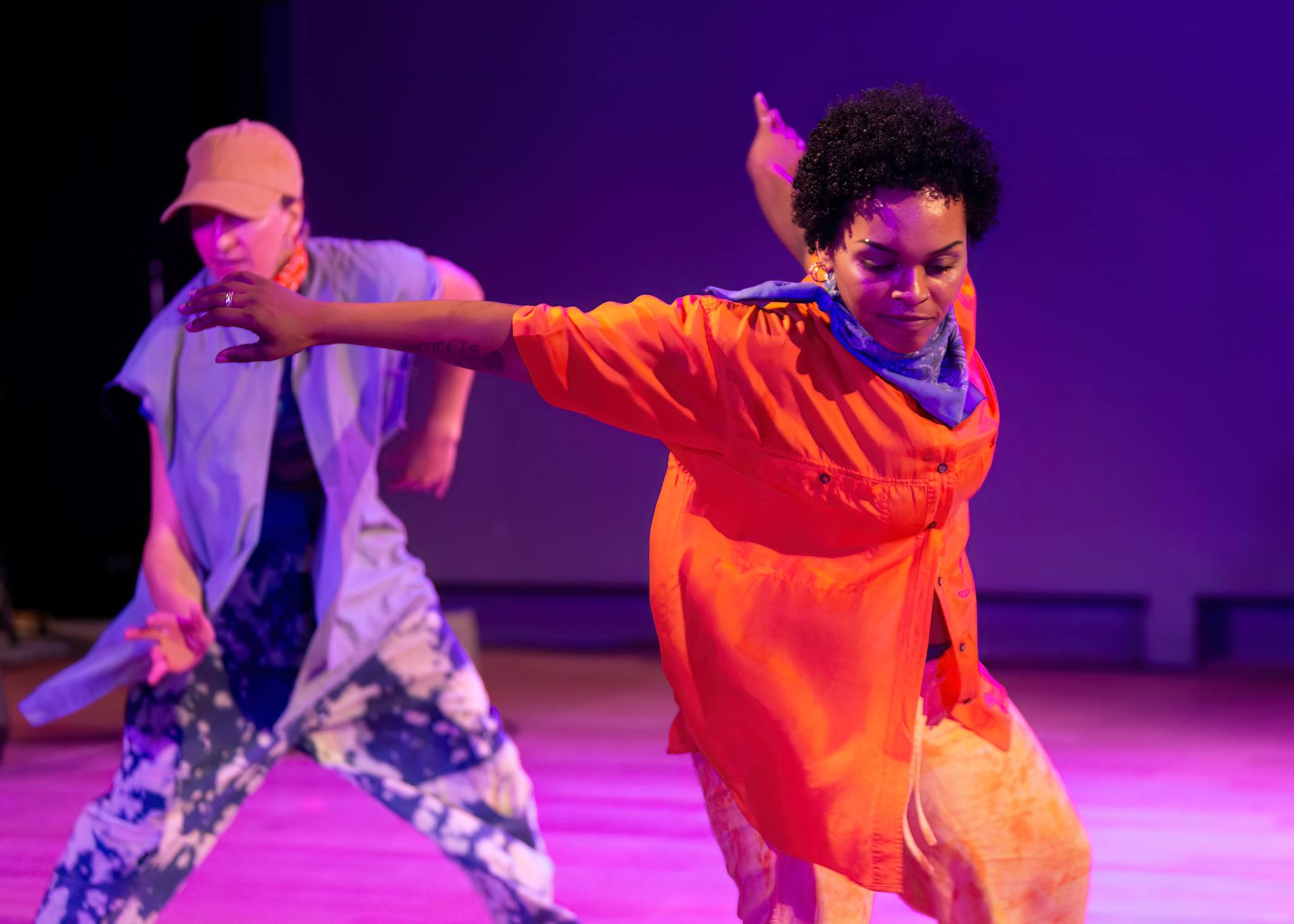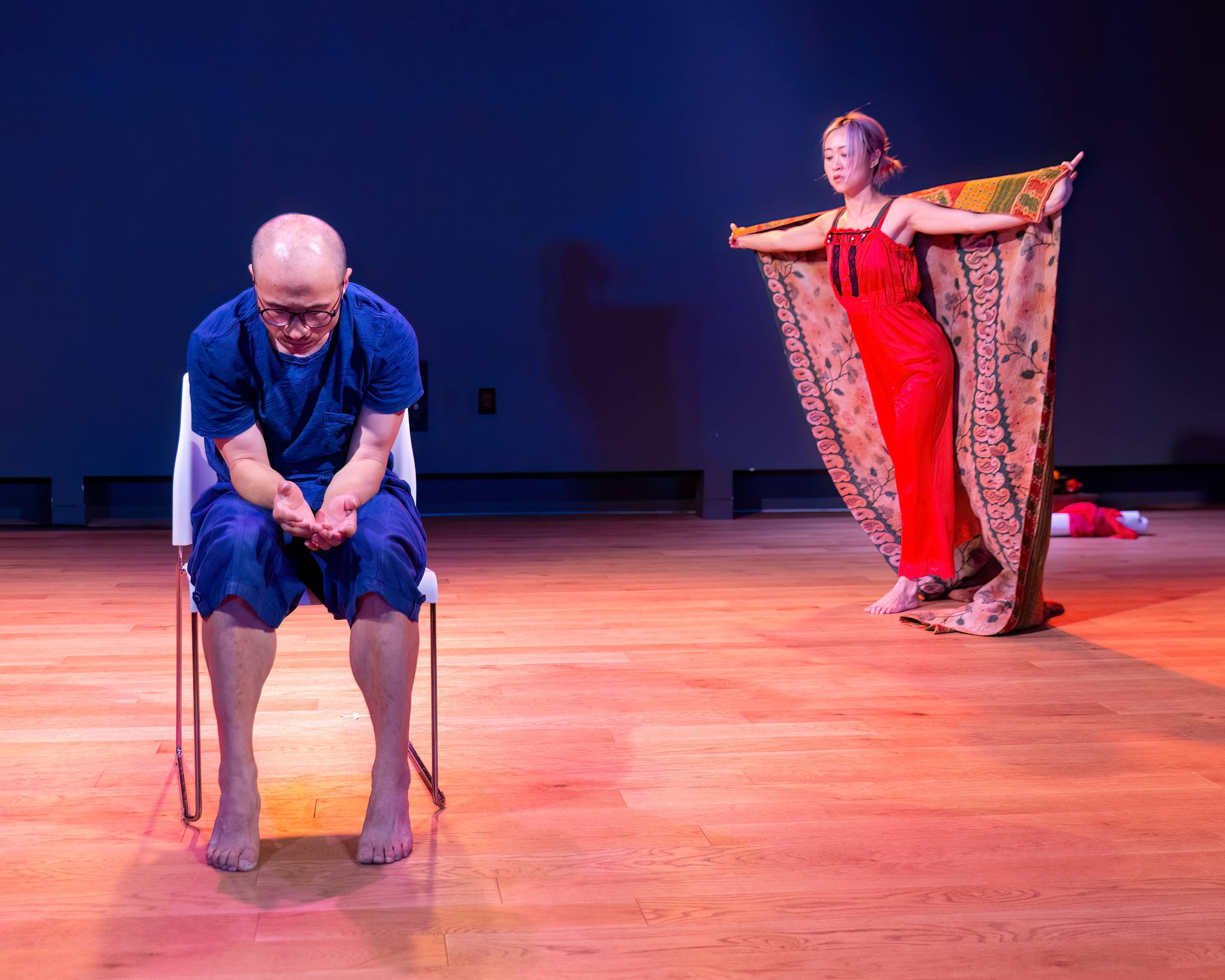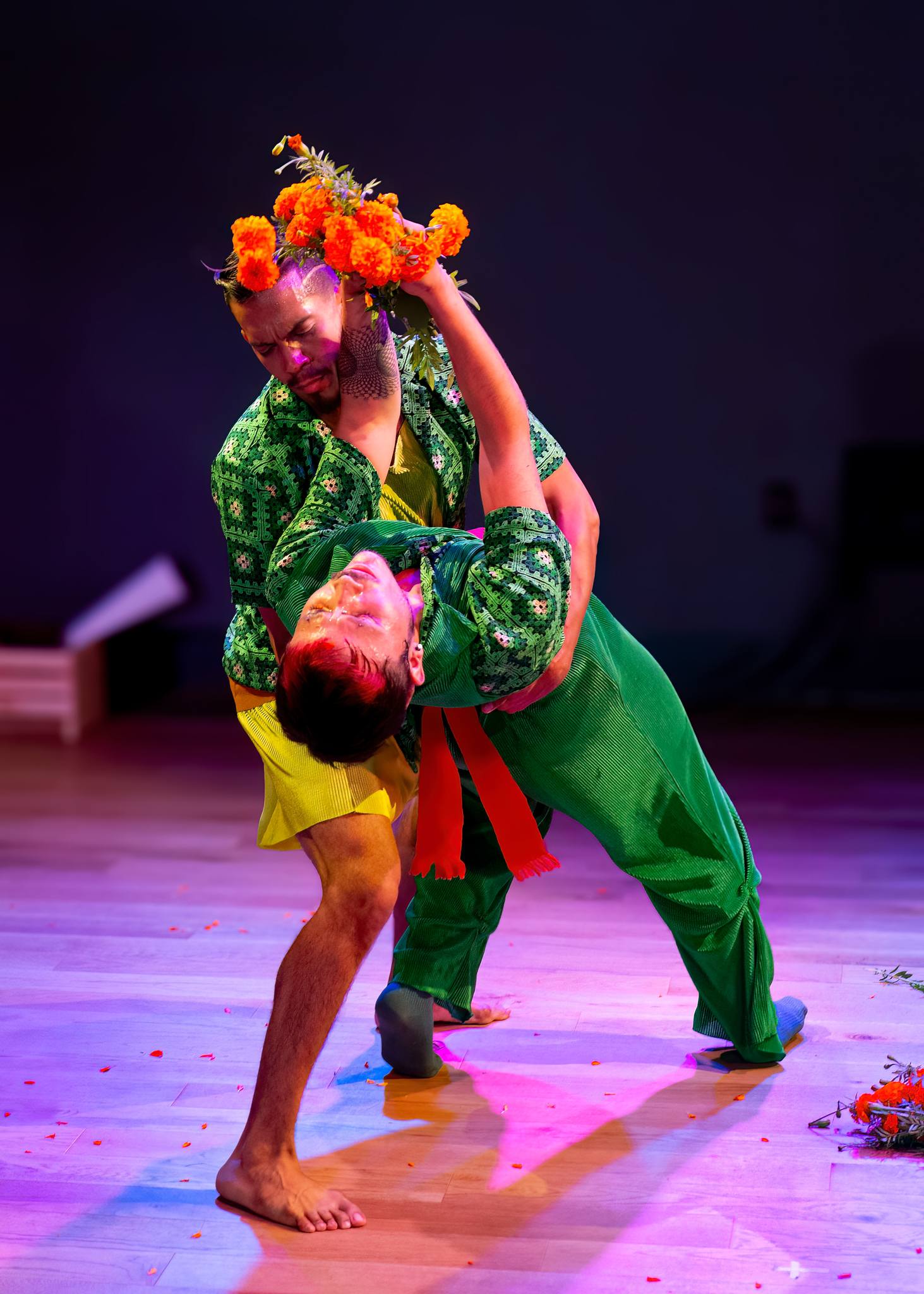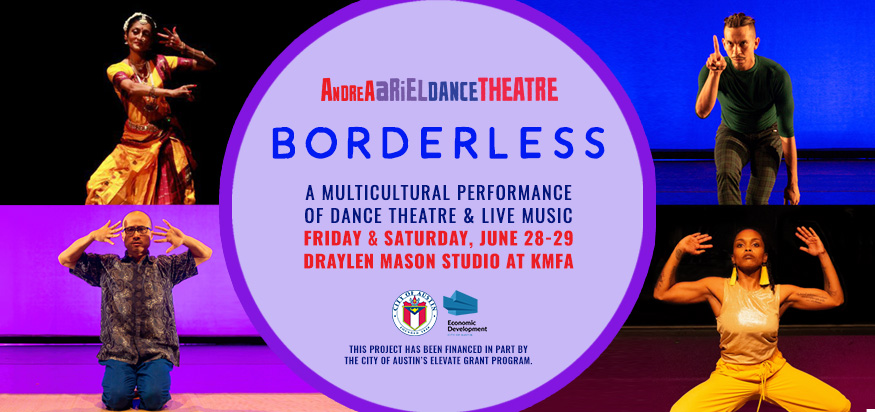Review: Borderless by Andrea Ariel Dance Theatre
by David Glen Robinson
Borders aren’t just the boundary lines between nations. Andrea Ariel Dance Theatre explored the many meanings of the term and how at the center of the concept borders divide. Hence the title Borderless and the theme of overcoming divisions among people. As Andrea Ariel writes in promotional material, “What connects us and disconnects [us] as humans across ethnicities and cultures?” She asked guest choreographers and musicians to answer that question and bring together their answers in this spectacular show at the Draylen Mason Music Studio, upstairs at KMFA 89.5.

The show was an intentional slow starter. One of the guest choreographers entered onstage as the audience members were still finding their seats. The performer unrolled a blank length of butcher paper. This act was followed by three others who performed the same action, until a long white cross or X in roll paper was constructed on stage. The performers then began writing their stories in color markers on their paper. The activity segued into “Our Stories and I-35,” one of five short transition pieces choreographed by Ariel. The others were entitled “Stranger Stories,” “Heartbeat,” “Making Bread Together,” and “Coming Together.” Each one had a progressively growing number of performers in the group, and the movements were no more and no less than movement exercises Ariel has conducted over the past year in her Community Voices Workshops. The multiethnic, multigenerational exercises in her workshops have lived on, surprisingly, in Borderless, but presented by professional dancers.
Borderless was disciplined and forthright, with diverse ethnicities performing throughout. The color design, notably, contrasted primary colors kaleidoscopically and told its own parallel story, lit clearly but subtly by Natalie George of Natalie George Productions. But what about those orange flowers?
Borderless moved richly in the traditions of the great cultures of the world. Still, while witnessing it, one might suspect that everything on stage was merely a vehicle for a strong stand-alone musical work by front-rank, highly gifted musicians. A strong Latin samba flavor had influences from contemporary rock. One piece began very much like Santana’s “Oye Como Va,” ("How's It Going?") the well-known 70s hit. Rey Arteaga created his driving rhythms from a rank of four congas with supplemental instruments, all percussive. Claude 9 McCan provided innovative melodies on keyboards and on the hybrid wind/keyed instrument named the melodion. It is rare to hear this instrument in performance. It is a regular tool in McCan’s musical kit. The other musicians, all dedicated to strings and drums, were Frederico 7, who played treble guitar and sang; Andres Acevedo on bass guitar; and Bruno Vinezof on the drum set.
 Guest choreographer Anuradha Naimpally and relatively new performer Purna Bajekal performed “Traditions,” choreographed by Naimpally, trained in Indian Bharata Natyam. The piece began as theatre ritual, the performers bringing out a small chest with two levels and outlined with rows of tea lights. The two performers adorned the chest, a representation of an altar or temple, with orange flower blossoms while a voiceover text played. Part of the text is quoted here: “The past lives on, the present thrives, and the future is forged, one step at a time—here and now.” The performers then danced that future, step by step. This reviewer has witnessed numerous duets of late and over the years. This duet was nearly unique, for it employed almost no touching, mirrorlike uniform phrasing, or the sculptural hand and arm shapes and postures for which Indian dance is known. All was to the music ensemble’s decidedly Western and Latin musical forms. This piece was a borderless merging of media—dance and music—and an exciting and new blending of time and traditional values. It was true to the title, spirit, and intent of the show.
Guest choreographer Anuradha Naimpally and relatively new performer Purna Bajekal performed “Traditions,” choreographed by Naimpally, trained in Indian Bharata Natyam. The piece began as theatre ritual, the performers bringing out a small chest with two levels and outlined with rows of tea lights. The two performers adorned the chest, a representation of an altar or temple, with orange flower blossoms while a voiceover text played. Part of the text is quoted here: “The past lives on, the present thrives, and the future is forged, one step at a time—here and now.” The performers then danced that future, step by step. This reviewer has witnessed numerous duets of late and over the years. This duet was nearly unique, for it employed almost no touching, mirrorlike uniform phrasing, or the sculptural hand and arm shapes and postures for which Indian dance is known. All was to the music ensemble’s decidedly Western and Latin musical forms. This piece was a borderless merging of media—dance and music—and an exciting and new blending of time and traditional values. It was true to the title, spirit, and intent of the show.
 “Groove Collective,” choreographed by Ciceley Fullylove, performed by Fullylove and Kelsey Oliver. The work borrowed heavily from hip-hop and street dance, although with contemporary dance phrasing and progressions. The musicians provided strong jazz inflections to the dance and a superfast tempo that made more impressive the dancers' sharp, tight unison work. Oliver was especially impressive for her strong, signature floor work. The piece was athletic; although taking place on the floor, it seemed to defy gravity. It was the kind of unrestrained, strenuous work that makes one worry for dancers' tendons and ligaments. To Fullylove, Oliver’s work and her own were another manifestation of joy, well expressed in the dance.
“Groove Collective,” choreographed by Ciceley Fullylove, performed by Fullylove and Kelsey Oliver. The work borrowed heavily from hip-hop and street dance, although with contemporary dance phrasing and progressions. The musicians provided strong jazz inflections to the dance and a superfast tempo that made more impressive the dancers' sharp, tight unison work. Oliver was especially impressive for her strong, signature floor work. The piece was athletic; although taking place on the floor, it seemed to defy gravity. It was the kind of unrestrained, strenuous work that makes one worry for dancers' tendons and ligaments. To Fullylove, Oliver’s work and her own were another manifestation of joy, well expressed in the dance.

“Shifting” turned yet another corner of diversity. The piece, from choreographer Jun “Sunny” Shen and dancer Siyan Li, showed us a blend of Western contemporary and Chinese contemporary dance. It also told a story of the pressures on modern Chinese women who enter a traditional family as brides but feel the pressure of modernity to become independent women. The movement showed a series of borders, boundaries, and limitations set before the female dancer, none more surprising than when she threw a cloth over the body of the male dancer sitting in a chair, then sat on his lap. When she tried to rise, two arms came from around the sides of the cloth and wrapped around her, restraining her. It was bizarrely expressive imagery, the kind we enjoy from “Sunny” Shen. Shen showed us the kind of pressures shared evident in very dissimilar cultures and much of the compassion needed to remedy their complaints.
 “Las Fronteras Del Tiempo (The Borders of Time)” by Luis Ordaz Gutiérrez was a story dance of passion, the kind that leaps over boundaries. Over it all, Federico7 sang the Portuguese song “Sodade” about longing for one’s homeland. The dance told us all that where we are in our discontents, anywhere, cannot stop us from finding our true homeland if we find a higher love. Nowhere in the dance was that better expressed than when Ordaz Gutierrez threw down his basket of props, the impedimenta of life, and began an energetic running in place toward a downstage diagonal--to get away, anywhere, just to go. His irrepressible sprite—spirit, perhaps significant other, danced by Irving Maldonado—began the same sequence, keeping up easily with Gutierrez, moving ahead, dropping back, smiling the while. If you cannot escape your problems, you also cannot escape your joys. In the final longish sequence, Gutiérrez retrieved his basket and from it removed hitherto unseen orange flowers, the leitmotif of the show. He and Maldonado adorned each other with the blossoms and danced to the end of the piece.
“Las Fronteras Del Tiempo (The Borders of Time)” by Luis Ordaz Gutiérrez was a story dance of passion, the kind that leaps over boundaries. Over it all, Federico7 sang the Portuguese song “Sodade” about longing for one’s homeland. The dance told us all that where we are in our discontents, anywhere, cannot stop us from finding our true homeland if we find a higher love. Nowhere in the dance was that better expressed than when Ordaz Gutierrez threw down his basket of props, the impedimenta of life, and began an energetic running in place toward a downstage diagonal--to get away, anywhere, just to go. His irrepressible sprite—spirit, perhaps significant other, danced by Irving Maldonado—began the same sequence, keeping up easily with Gutierrez, moving ahead, dropping back, smiling the while. If you cannot escape your problems, you also cannot escape your joys. In the final longish sequence, Gutiérrez retrieved his basket and from it removed hitherto unseen orange flowers, the leitmotif of the show. He and Maldonado adorned each other with the blossoms and danced to the end of the piece.
Producers, musicians, dancers, and technicians showed their immense commitment to this presentation. The light and sound were exceptional in the well-appointed Draylen Mason Music Studio. Natalie George's company shouldered overall production duties, including her lighting design. Elise Etherton designed sound and operated the board. Eric Graham of IC Pictures produced multi-camera video documentation. Costume design and color concept were not credited, though one suspects that ithey were a collaboration between Ariel and the artistic partner collective. Steve Rogers, as usual, took amazing photographs. Every image spoke to the themes of Borderless.
Borderless is gone now, but followers must surely be inspired by what they have just witnessed. New potential audiences can follow Andrea Ariel Dance Theatre here on CTXLiveTheatre.com, of course, and on the usual social media.
Borderless
by Andrea Ariel Dance Company
Andrea Ariel Dance Theatre
June 28 - June 29, 2024
June 28-29, 2024
Draylen Mason Music Studio at KMFA, Austin
